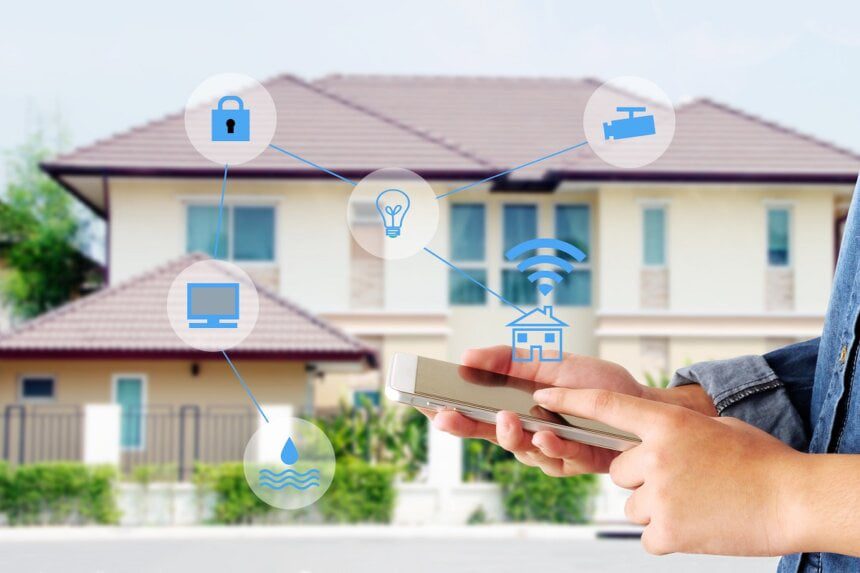There was a time when the Internet of Things (IoT) was discussed as a far-fetched concept in the world’s leading R&D departments. Today, various IoT-enabled solutions are available to the majority of consumers, allowing them to reduce utility bills, use water and electricity more rationally, and make their lives more convenient than ever before.
An IoT network consists of a vast array of very small, low-cost, and energy-efficient devices that can be connected to the internet. These objects, which are often referred to as “things,” can detect and measure data, communicate with other devices, and send the collected data for processing by analytical software.
In this article, we will review practical applications of IoT which can be implemented in any home.
Smart security
Regardless of the neighborhood, nobody is truly insured against home burglaries and theft. Meanwhile, IoT emerges as one of the most reliable methods for making our homes more secure.
For example, by installing motion trackers near possible home entry points, including windows, rooftops, garages, and doors, homeowners can get instantly notified when there is an unusual movement. Smart security cameras which can track motion inside can automatically alert the homeowner when any suspicious activities are detected. Depending on the intricacy of the system, it can even automatically notify an emergency team, which will immediately come to investigate.
For example, Ring Alarm is a comprehensive home security system that safeguards households from break-ins, flooding, fire, and more. The system can be customized depending on the owner’s needs but typically includes motion sensors, smoke detectors, and intelligent cameras. Importantly, if the home’s power goes out, Ring Alarm’s backup battery will be automatically activated.
Smart gardening
In the majority of households, caring for plants and gardens comes down to intuition and tradition. While such an approach is sufficient for some homeowners, those who want to up their gardening game should look into IoT-enabled gardening systems. IoT has already proven to be an invaluable tool for many farmers worldwide, so the same type of technology can be used by homeowners but on a smaller scale.
The most basic applications of IoT in gardening involve using sensors for tracking environmental conditions such as temperature, humidity, and sunlight levels to adjust irrigation schedules and get a better insight into plants’ well-being. This can drastically reduce water usage, decreasing a household’s water bills and boosting the effectiveness of gardening efforts.
For example, Parrot Flower Power is a wireless plant sensor that can collect data on soil moisture, temperature, and fertilization levels and provide personalized recommendations for watering, addressing the specific needs of your plants.
Smart heating
As energy becomes an increasingly precious resource, more and more homeowners turn to smart heating solutions. HVAC systems that you can control remotely have been around for some time now. When coupled with advanced analytics technologies, IoT-enabled heating and cooling systems can take into account current weather conditions, time of the day, whether you are at home or not, and, most importantly, your preferred HVAC settings that it learned over time. Moreover, such systems can alert you if something goes wrong or needs your attention. For example, the Cielo Home app can automatically detect if your air conditioning filter needs a cleanup.
One of the most popular devices in this category is Google’s Nest Thermostat. Nest’s setup includes asking a user about his or her daily routine, which it uses to create an automatic schedule. By optimizing heating and cooling cycles and using only the amount of energy that needs to be used, homeowners can save a considerable amount of resources, reducing utility bills and contributing to energy preservation as a whole.
Energy management
IoT plays a vital role in optimizing energy consumption and improving energy efficiency in smart homes. Smart energy monitoring systems can provide real-time insights into energy usage, allowing homeowners to identify energy-hungry devices or patterns of wastage. Based on this information, users can make informed decisions about energy conservation and cost savings. IoT-enabled smart plugs and power strips also enable remote control and scheduling of devices, helping to eliminate energy waste by turning off appliances when not in use or during specific time periods.
Afterword
The emergence of IoT-enabled devices in the consumer market has opened up a world of possibilities for homeowners who want to make their living spaces smarter and more comfortable. Whether it’s security, gardening, heating, or energy management – there’s an IoT device for nearly any need. With new products constantly emerging and existing solutions becoming more affordable, homeowners are increasingly using IoT-based solutions to meet their home needs, and this trend is only likely to grow.







